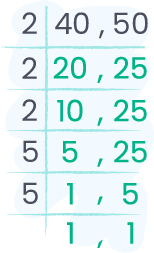What is the Least Common Multiple (LCM)?
The least common multiple or lowest common multiples is the least number that is divisible by the numbers for which you are finding the LCM.
For example:
The L.C.M of 3, 5 and 6 is 30.
This means that the 30 is the common number that can be divided by any of the numbers between 3,5 and 6 to get the answer in integers.
Methods of finding the LCM
There are multiple methods of finding the Lowest common multiple between multiple numbers. Some of the ways are discussed below:
- Listing Multiples
- Prime Factorization
- Prime Factorization using exponents
- Cake Method (also known as ladder method)
- Division Method
How to find LCM?
The best method is to use our LCM Calculator. But if you want to find it manually, then as discussed above there are several methods to find LCM of two or more numbers.
Here, we go through some important methods with detailed steps to understand the basic idea of how to find the LCM.
1. Prime Factorization
Prime factorization is a simple method to find the LCM. Let’s see how to find LCM using prime factorization step by step.
Example:
Find LCM of 400, 500, and 550 with prime factorization?
Solution:
Step 1: List the factors of the given numbers.
400: 5 × 5 × 2 × 2 × 2 × 2 = 52 × 24
500: 5 × 5 × 5 × 2 × 2 = 53 × 2 2
550: 5 × 5 × 2 × 11 = 52 × 2 × 11
Step 2: Multiply the prime factors to get the LCM. If there are common factors, use them only once.
53 × 24 × 11 = 22000
So, the least common multiple of 400, 500, and 550 is 22000.
To verify the LCM answer of 400, 500, and 550 by prime factorization using our LCM Calculator that provides the answer with detailed steps.
2. Division Method
The division method is another method to get the LCM of multiple numbers. Follow the below steps to obtain the least common multiple using the division method.
Example:
Find the least common multiple of 40 and 50 with the division method?
Step 1: Place all numbers on a horizontal line as shown in the image below.

Step 2: Start dividing the numbers with the least prime number. Write the quotient of division exactly below the dividend. Keep dividing until all numbers are fully divided and the remainder is 1.

Step 3: Multiply all of the divisors to get the LCM.
2 × 2 × 2 × 5 × 5 = 200
So, the LCM of 40 and 50 is 200 using the division method.
Alternatively, use our above LCM Calculator to find the LCM of 40 & 50 by using the division method to overcome the manual long method.
3. Listing Multiples
The simplest way to find the LCM of any numbers is to find through the listing multiples. In this method, you have to list down all the multiple of the numbers and then find the common multiple between these numbers which would be the LCM.
Example:
Find the LCM of 8 and 14 using lists of multiple method?
Step 1: Write down the multiples of the given numbers.
Multiples of 8 = 8, 16, 24, 32, 40, 48, 56, 64, 72
Multiples of 14 = 14, 28, 42, 56, 70, 84
Step 2: Look out for the common multiple in the multiples of all numbers.
Multiples of 8 = 8, 16, 24, 32, 40, 48, 56, 64, 72
Multiples of 14 = 14, 28, 42, 56, 70, 84
As we can see that the common number between the multiples of 8 and 14 is 56, which is the least common factor for these numbers.
LCM of 8 and 14 = 56
Moreover using our above LCM finder to calculate the least common multiple of 8 and 14 with the help of the lists of multiple methods.
Properties of LCM
- It is associative
- It is commutative
- It is distributive
LCM Formula
Finding the LCM through GCF
Finding the least common multiple with the value of the greatest common factor is possible with the following formula:LCM(a,b) = (a x b) / GCF(a,b)
Example:
The LCM of (8,14)
GCF(8,14) = 2
Using formula: (8 x 14) / 2
LCM = 56
LCM Examples
| Questions | Answer | Action |
|---|---|---|
| lcm of 9 and 12 | 36 | Convert |
| lcm of 8 and 14 | 56 | Convert |
| lcm of 9 and 15 | 45 | Convert |
| lcm of 8 and 12 | 24 | Convert |
| lcm of 6 and 9 | 18 | Convert |
| lcm of 12 and 15 | 60 | Convert |
| lcm of 8 and 10 | 40 | Convert |
| lcm of 4 and 6 | 12 | Convert |
| lcm of 10 and 12 | 60 | Convert |
| lcm of 6 and 12 | 12 | Convert |
| lcm of 15 and 20 | 60 | Convert |
| lcm of 12 and 18 | 36 | Convert |
| lcm of 16 and 20 | 80 | Convert |
| lcm of 24 and 30 | 120 | Convert |
| lcm of 8,12 and 16 | 48 | Convert |
| lcm of 9,10 and 28 | 1260 | Convert |
FAQ’s
What is LCM?
LCM is the short form of the least common multiple. It is the smallest common multiple of two or more numbers and is divisible by all numbers that involved in the least (lowest) common multiple calculations.
How to find the least common multiple of two numbers?
For instant solution, use our LCM calculator & calculate least common multiple of two numbers. But if you find it manually, choose one of the methods to find the LCM. Then, follow the process of selected method & calculate LCM of two numbers.
What is LCM of 8 and 12?
The LCM of 8 & 12 is 24. See the below steps on how to find the LCM of 8 & 12 by prime factorization. For this, find the prime factors of 8 & 12.
8 = 2 x 2 x 2 = 23
12 = 2 x 2 x 3 = 22 x 3
LCM (8,12) = 23 x 3 = 24
To verify the answer of the LCM of 8 & 12 with other methods, use our lowest common multiple calculator and get accurate LCM instantly.
What is LCM used for?
LCM is used to find the least (lowest) common multiple of two or more numbers and lowest common denominator of two or more fractions.


